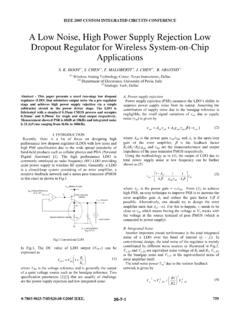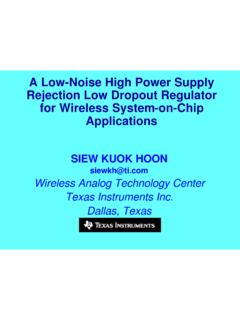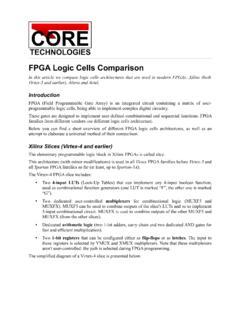Transcription of Industrial SensorsIndustrial Sensors
1 1 Industrial Sensors Industrial Sensors Proximity Mechanical Optical Inductive/Capacitive Position/Velocity Potentiometer LVDT Encoders Tachogenerator Force/Pressure Vibration/acceleration 2 Definitions Definitions Accuracy: The agreement between the actual value and the measured value Resolution:The change in measured variable to which the sensor will respond Repeatability:Variation of sensor measurements when the same quantity is measured several times Range: Upper and lower limits of the variable that can be measured Sensitivityand LinearityProximity SensorsProximity Sensors Widely used in general Industrial automation Conveyor lines (counting,jam detection, etc) Machine tools (safety interlock, sequencing) Usually digital (on/off) Sensors detecting the presence or absence of an object Consist of: sensor head: optical, inductive, capacitive Detector circuit Amplifier Output circuit.
2 TTL, solid state relayMechanical Proximity SwitchesMechanical Proximity Switches Essentially a mechanical switch On/off operation only Two general modes Normally Open (NO) Normally Closed (NC) Come in a wide variety of mechanical forms For a wide range of usesActuatorCommonNormallyClosedNormally OpenExample Mechanical Example Mechanical Proximity Switches Proximity Switches 3 When to Use Mechanical When to Use Mechanical Proximity SwitchesProximity Switches Where physical contact is possible Where definitive position is required In operation-critical or safety-critical situations Where environment conditions preclude the use of optical or inductive sensorsApplications and Use of applications and Use of
3 Mechanical Proximity SwitchesMechanical Proximity Switches Easy to integrate into machinery of all types Requires contact (thus wear) Range of voltages: DC 0-1000V, AC, etc. Very robust (explosion proof if required) Usually used as: Limit switch Presence/absence indicator Door closed/openPlaces You Find Mechanical Places You Find Mechanical Proximity Switches !Proximity Switches !Optical Proximity SensorsOptical Proximity Sensors Consist of a light source (LED) and light detector (phototransistor) Modulation of signal to minimize ambient lighting conditions Various models: 12-30V DC, 24-240V AC, power Output: TTL 5V, Solid-state relay, SignalPower SupplyLoad4 Operational ModesOperational Modes Through Beam: Long range (20m) Alignment is critical !
4 Retro-reflective Range 1-3m Popular and cheap Diffuse-reflective Range 12-300mm Cheap and easy to useExample Optical Proximity IExample Optical Proximity IOptical Fibre Delivery SystemExample Optical Proximity IIExample Optical Proximity IISlot BeamSystemsWhen to use an Optical When to use an Optical Proximity SensorProximity sensor Pros Non-contact, no moving parts, small. Fast switching, no switch bounce. Insensitive to vibration and shock Many configurations available Cons Alignment always required Can be blinded by ambient light conditions (welding for example) Requires clean, dust and water free, environment5 applications of Optical Proximity applications of Optical Proximity SensorsSensors Stack height control/box counting Fluid level control (filling and clarity)
5 Breakage and jam detection And many Optical Devices Other Optical Devices LightCurtainCollision DetectionUltrasonic Proximity SensorsUltrasonic Proximity Sensors Use sound pulses Measures amplitude and time of flight Range provides more than on/off information Frequencies 40 KHz-2 MHzPulseEchoVibrating Membrane(metal or ceramic)SensorObjectWhen to use Ultrasonic SensorsWhen to use Ultrasonic Sensors Provide range data directly: Level monitoring of solid and liquids Approach warning (collisions) Can (usually) work in heavy dust and water Ambient noise is potentially an ApplicationsExample ApplicationsCar Wash ApplicationPaper roll Thickness MonitorWaste water flow volumeInductive and Capacitive Inductive and Capacitive Proximity SensorsProximity Sensors Inductive Sensors use change in local magnetic field to detect presence of metal target Capacitive Sensors use change in local capacitance caused by non-metallic objects Generally short ranges only Regarded as very robust and reliableExample Inductive Sensors IExample
6 Inductive Sensors IDetection of open/close functionsDetection of rotationExample Inductive Sensors IIExample Inductive Sensors IIBulk mounted inductivesensors. Detect presence ofobject without 3mm +/- 10%7 Example Capacitive SensorsExample Capacitive SensorsPanel Mounted Capacitive sensor . Can detect wood, plastic and metal. Range 3mm-25mmFlat mounted CapacitiveSensor. Used for detecting panels of glass. Range=10mm +/- 10%Position and Velocity SensorsPosition and Velocity Sensors Position and velocity measurement is often required in feedback loops For positioning, and velocity control Position measurement: Potentiometers LVDT Encoders Velocity Measurement.
7 TachometerPotentiometers Potentiometers RVinVoutAn analog sensorWorks as a voltage dividerTypes of PotentiometerTypes of Potentiometer Wirewound Wiper slides along coil of Ni-chrome wire Wire tends to fail, temperature variations Cermet Wiper slides on conductive ceramic track Better than wire inmost respects Plastic film High resolution Long life and good temperature stability8 Linear PotentiometersLinear PotentiometersWhen to use a PotentiometerWhen to use a Potentiometer Pros Require analog signal for control Require absolute positional information Low cost Cons Temperature and wear variations Not in dusty or wet environments Linear Variable Differential Linear Variable Differential Transformer (LVDT)Transformer (LVDT)
8 An LVDT consists of a magnetic core that moves in a cylinder The sleeve of the cylinder contains a primary coil that is driven by an oscillating voltage The sleeve also contains two secondary coils that detect this oscillating voltage with a magnitude equal to displacement The automatic nulling that can be achieved using two coils makes LVDTs very accurate (submillimetre)Vinsin tVoutsin( t+ )Phase measurementLVDT Signal ConditioningLVDT Signal Conditioning Uses AC modulation, demodulation and phase comparison Available in a single monolithic packagePowerSupplyCarrierOscillatorAmpli tudeControlLVDTC urrentAmplifierDemodulatorPhaseShifterZe roSetAC Power93 Example Example LVDTsLVDTsSpring-loaded Standard for use In hydraulic cylindersFree core LVDTs for use in hostile environmentsAnd total emersionWhen to use an LVDTWhen to use an LVDT High accuracy Linear operation (synchro resolver is equivalent rotary LVDT)
9 Harsh environment Analog position control Embedding (in cylinder for example)Optical EncodersOptical Encoders Encoders are digital Sensors commonly used to provide position feedback for actuators Consist of a glass or plastic disc that rotates between a light source (LED) and a pair of photo-detectors Disk is encoded with alternate light and dark sectors so pulses are produced as disk rotatesEncoder Internal Structure Encoder Internal Structure 10 Incremental EncodersIncremental Encoders Pulses from leds are counted to provide rotary position Two detectors are used to determine direction (quadrature)
10 Index pulse used to denote start point Otherwise pulses are not uniqueAbsolute EncodersAbsolute Encoders Absolute encoders have a unique code that can be detected for every angular position Often in the form of a grey code ; a binary code of minimal change Absolute encoders are much more complex and expensive than incremental encodersEncoder processingEncoder processing Need a squaring circuit to digitise signal A counter and index monitor Generally available in monolithic form Often with algorithms for control externally programmableWhen to Use an EncoderWhen to Use an Encoder Require accurate position information: 10,000 line incremental 360 line absolute Digital feed-back loop Compact and reasonabl



















